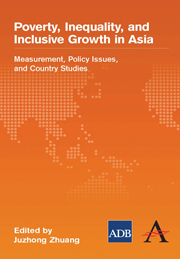Book contents
- Frontmatter
- Contents
- Foreword
- Preface and Acknowledgments
- Contributors
- Abbreviations, Acronyms, and Symbols
- Tables, Figures, and Boxes
- 1 Poverty, Inequality, and Inclusive Growth in Asia
- Part A Measuring Inequality and Poverty
- Part B Selected Policy Issues for Inclusive Growth
- Part C Country Studies
- 9 Growth, Inequality, and the Labor Market: The Philippines
- 10 Poverty and Inequality in Nepal: An Empirical Analysis
- 11 Decomposing Income Inequality: People's Republic of China, 1990–2005
- 12 Evolution of Income Mobility: People's Republic of China, 1991–2002
- 13 Occupational Segregation and Gender Discrimination in Labor Markets: Thailand and Viet Nam
- 14 Inclusiveness through Food Security: The Philippines' National Food Program
- Index
10 - Poverty and Inequality in Nepal: An Empirical Analysis
from Part C - Country Studies
Published online by Cambridge University Press: 05 March 2012
- Frontmatter
- Contents
- Foreword
- Preface and Acknowledgments
- Contributors
- Abbreviations, Acronyms, and Symbols
- Tables, Figures, and Boxes
- 1 Poverty, Inequality, and Inclusive Growth in Asia
- Part A Measuring Inequality and Poverty
- Part B Selected Policy Issues for Inclusive Growth
- Part C Country Studies
- 9 Growth, Inequality, and the Labor Market: The Philippines
- 10 Poverty and Inequality in Nepal: An Empirical Analysis
- 11 Decomposing Income Inequality: People's Republic of China, 1990–2005
- 12 Evolution of Income Mobility: People's Republic of China, 1991–2002
- 13 Occupational Segregation and Gender Discrimination in Labor Markets: Thailand and Viet Nam
- 14 Inclusiveness through Food Security: The Philippines' National Food Program
- Index
Summary
Introduction
Nepal made significant progress in reducing poverty between 1995– 1996 and 2003–2004, despite political instability. However, poverty incidence remains high–estimated at about 31% in 2003– 2004–and inequality also increased during this period. Based on the Gini coefficient, inequality rose from about 34.2 in 1995–1996 to about 41.4 in 2003–2004, the highest in South Asia. Such trends seem to suggest the limited inclusiveness of Nepal's recent economic growth. Given that poverty and inequality are considered among the most significant drivers of recent internal conflicts, it is important that a new growth strategy opens up economic opportunity to excluded groups.
Inclusive growth not only generates economic opportunity, but also ensures equal access. Hence, growth is said to be inclusive when it allows all members of society to participate in, contribute to, and benefit from the growth process on an equal basis, regardless of individual circumstance (Ali and Zhuang 2007). This is a particularly relevant question for Nepal, where exclusion remains an important development hurdle (World Bank and DFID 2006).
This chapter assesses the inclusiveness of Nepal's recent economic growth and examines what factors helped certain groups of households escape poverty between 1995–1996 and 2003–2004. The findings of the analysis will assist policy makers in formulating measures to enhance the inclusiveness of growth and poverty reduction. The empirical analysis is based on data from the Nepal Living Standards Surveys conducted in 1995–1996 (NLSS I) and in 2003–2004 (NLSS II).
- Type
- Chapter
- Information
- Poverty, Inequality, and Inclusive Growth in AsiaMeasurement, Policy Issues, and Country Studies, pp. 344 - 366Publisher: Anthem PressPrint publication year: 2010
- 1
- Cited by



